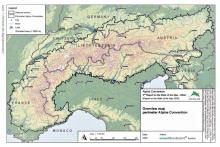ALPINE CONVENTION
The Alpine Convention is a pioneer
In the 1990s, it was the world's first international agreement to consider a transnational mountain region in its entirety. The Convention signed by the eight Alpine countries Austria, Germany, Italy, France, Switzerland, Liechtenstein, Slovenia and Monaco as well as by the European Union. The Alpine Convention has been in force since 1995.
Common territory and common goals
The contracting parties share a common territory, face common challenges and have common goals: the protection and sustainable development of the Alps.
The Alps are a natural, cultural, living and economic space for more than 14 million inhabitants. Every year, many tourists spend their holidays in this mountainous area in the heart of Europe.
History of the Alpine Convention
The elaboration of an Alpine Convention already identified as one of the main objectives of the International Alpine Protection Commission CIPRA in 1952. At CIPRA's suggestion, a unanimous plenary resolution passed in the European Parliament on 17th May 1988 to draw up a "Convention on the Protection of the Alpine Region". An 89-point resolution of the environment ministers at the first Alpine Conference in Berchtesgaden in 1989 led to the concrete commitment to formulate a treaty binding under international law between the eight Alpine states and the EEC.
The Alpine Convention signed in Salzburg on 7th November 1991 by Austria, France, Germany, Italy, Liechtenstein, Switzerland and the EEC. Slovenia signed the Convention in 1993 and Monaco became on the basis of a separate additional protocol a contracting party in 1994. The Convention entered into force in 1995. Further specific obligations laid down in eight thematic protocols.
The Alpine Convention is a unique, legally binding sustainability instrument that aims to preserve the sensitive alpine ecosystems together with regional cultural identities, heritage and traditions in the Alps for future generations. The Alpine Convention is also a political arena where the Contracting Parties, in cooperation with many observer organisations, have built up great expertise over many years.
07.10.2025
CatchHedge - Potenziale von Hecken im Zeichen des Klimawandels
more ...16.+17.09.2025
32nd Conference of the Danube Region
more ...12.09.2025
Grundlagen der professionellen Bio-Mandel-Produktion
more ...10.09.2025
Agroforst u. Marktgärtnerei, Symbiose
more ...25.06.2025
Feldtag - StripTill im Bio-Mais im Trockengebiet
more ...25.06.2025
Seminar: Wildbienen- und Nützlingsförderung im Biolandbau
more ...24.06.2025
BOKU Green Plate Forum 3.0
more ...24.06.2025
Die Maulbeere - Kultur, Produktion u.Verwendung
more ...17.06.2025
Frühjahrstagung Österr. Gesellschaft für Agrar- und Umweltrecht (ÖGAUR)
more ...13.06.2025
Seminar: Artenvielfalt in Ackerbauregionen fördern
more ...03.06.2025
Seminar: Keine Angst vor der Ackerdistel
more ...03.06.2025
Agroforstsysteme: Anbau-Modelle der Zukunft
more ...20.05.2025
IDM-Generalversammlung 2025
more ...15.05.2025
Seminar: Unkräuter/Beikräuter erkennen und als Zeigerpflanzen nutzen
more ...13.+14.05.2025
Bodenforum Österreich - Frühjahrstreffen
more ...04.05.2025
Tageskurs: Perma-Veggies - Mehrjähriges Gemüse und essbare Stauden
more ...03.05.2025
Waldgärten-Exkursion
more ...08.04.2025
Agroforst: Traditionelle Systeme von Land- und Forstnutzung verbinden
more ...26.+27.03.2025
Tagung "Weniger Bodenversiegelung, mehr Zukunft - wie gelingt das?"
more ...20.+21.03.2025
Vitiforst - wie integriere ich Gehölze in meinen Weingarten?
more ...



